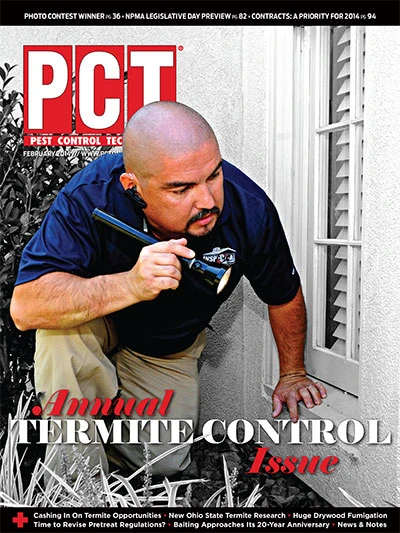 Editor’s note: How many times have you treated or identified something without closely looking at it or inspecting it? You were certain what it was at the time, but later found that it wasn’t what you thought. By then it was too late, time and materials had been spent and perhaps wasted, and the pest or the problem remained. Worse, your competitor got it right and got the job. We all have done that at least once — made a quick decision without looking, reading or inspecting closely.
Editor’s note: How many times have you treated or identified something without closely looking at it or inspecting it? You were certain what it was at the time, but later found that it wasn’t what you thought. By then it was too late, time and materials had been spent and perhaps wasted, and the pest or the problem remained. Worse, your competitor got it right and got the job. We all have done that at least once — made a quick decision without looking, reading or inspecting closely.
These scenarios are the ones that a new book from William H Robinson seeks to prevent. The “Service Technician’s Inspection and Identification Manual” is the second book of the “Practical Guide for Pest Control Professionals” series by Robinson.
The following is excerpted from the manual, detailing the importance of and essential steps in inspection and identification.
Inspection and pest identification are critical steps in a pest prevention and control program. Inspections require knowing where to look and what to look for, and they improve only with success and experience. Identifying what is found also is important, to the customer and to the treatment method. A thorough inspection of suspected harborages and feeding sites will show the extent of the infestation and where to treat. This improves application efficacy and reduces costs. Residential and commercial customers rely on service technicians to inspect before they treat and to monitor after they treat.
Thus, the first step in any pest management program is an inspection of the site to determine the location and population of the target pest. With this information:
- the best chemical and non-chemical methods can be determined for control.
- information on pest-conducive conditions in the indoor or outdoor habitat is gained.
- the pest(s) can be identified and food and harborage requirements determined to enable the implementation of preventive measures.
The Inspection.
The procedure for residential and commercial inspections is to search for the presence or other evidence of the target pest. The time devoted to inspections is often limited, and it may not overlap pest activity periods or the life stages that are the most active. Thus, a few things to consider during your inspections are:
Expected vs. Found. Insects, spiders and vertebrates that may be found during any inspection depend on the time, day, season and conditions at the location. Pests seen by a customer one day may not be seen on the day the service technician arrives to conduct an inspection. Thus, the technician should look for signs or other evidence of pest presence, even if no pest is seen.
Conditions. Insects, spiders and rodent pests require a set of suitable conditions to survive; these include relative humidity or moisture, food and harborage. Although the range and quality of requirements vary by pest, these are basic requirements for survival and for populations to grow to infestation levels. However, harborage is often overlooked as an important survival requirement. For many insects it is crucial, and potent aggregation pheromones are deposited there to maintain large numbers and attract males and females.
Prevention. An inspection must have the added objective of identifying the source of the target pests and the conditions that permit the infestation or the points of access for these pests. Once the conditions enabling the infestation are identified and changed or the entry point sealed (non-chemical methods), there can be long-term control. Without some level of prevention, control will be less effective and infestations will persist. Inspection provides the opportunity to find and identify the pest and to determine immediate and lasting control methods.
|
Ideal for carrying in the service vehicle for quick, on-the-spot identification of pests, the 124-page Service Technician’s Inspection and Identification Manual is available from PCT’s Online Bookstore (www.pctonline.com/store) for $29.95. The manual is a part of the Practical Guide for Pest Control Professionals series by William H Robinson. Its purpose is to make inspection and identification easier for service technicians by first providing information to help the technician anticipate common pests or damage that will be found during site inspections, then linking that to detailed information on, and illustrations of, more than 200 pests and damage. The goal is to provide a single book with guidelines for inspection and a means of confirming what was found. |
Monitoring.
Sticky traps and UV lights are ideal for monitoring or detecting the indoor presence of pests before and/or after chemical or non-chemical treatment.
- Sticky Traps. Careful inspection of the insects captured on sticky traps can provide information on the location of infested harborages. The traps can be dated and saved to provide evidence of declining or increasing pest numbers. Insects and spiders captured on the glue will remain intact for months, at least for the time necessary to use them to show service progress. Sealing the traps in plastic bags will prevent other insects or rodents from eating the captured specimens.
- UV Light Traps. The insects captured by ultraviolet (UV) light traps can show the presence of pest infestations, particularly moths and some beetles. The monthly capture data can be used to track the life cycle of the pests, as indicated by the increase and decrease of number of adults captured. Because insects, such as click beetles, flesh flies and sod webworm adults, also will be attracted to these lights, their presence on the glueboards will mean that there is an opening they used to enter, and may indicate that an air curtain is not adjusted or a door or window is not closed.
The Pests
Colony. These ants are active all year, and colonies can be large. New colonies are formed when a young queen and a small number of workers split from the parent colony. Habits. Workers forage 24 hours a day and use chemical trails. Indoors, they feed on sweets, meat, grease and a variety of other materials.
Development. Eggs are laid directly on a substrate; the female lays about 600 eggs in her lifetime. Hatching occurs in 12 to 24 hours. Larval development from egg to adult is eight to 10 days. Adults emerge in about four days, and live about 30 days in humid conditions. Habits. Larvae feed in decaying fruit and vegetables. The larva’s posterior breathing tube is short; it does not feed deep below the surface of the food substrate. |

Explore the February 2014 Issue
Check out more from this issue and find your next story to read.
Latest from Pest Control Technology
- Moving Day for Oriental Cockroaches
- Pest-End Hosts Annual Company Event to Celebrate Growth, Awards Ceremony
- IPMA Announces Doug Foster as 2025 Hall of Fame Award Winner
- Hogarth's Pest Control Using Meta AI Glasses for Pest Identification, In-Field Photography
- OcuTrap Uses Remote Monitoring Technology to Improve Capture Rates
- Skedaddle Wildlife Opens Columbus (OH) Franchise Location
- UCCE Orange County Partners with Newport Exterminating to Resolve Mouse Infestation
- Arab Termite & Pest Control Celebrates 50 Years in Business
 How to Order the Inspection and Identification Manual
How to Order the Inspection and Identification Manual  Pharaoh Ant
Pharaoh Ant Red-Eye Fruit Fly
Red-Eye Fruit Fly




